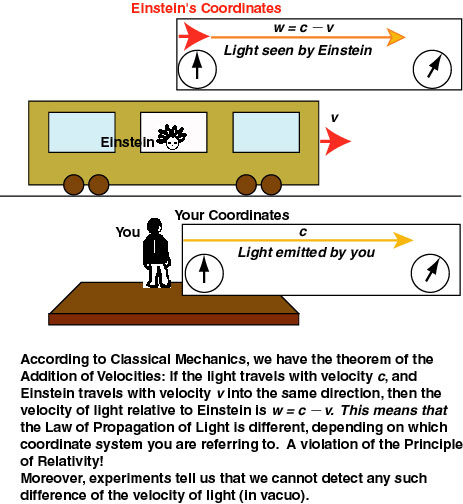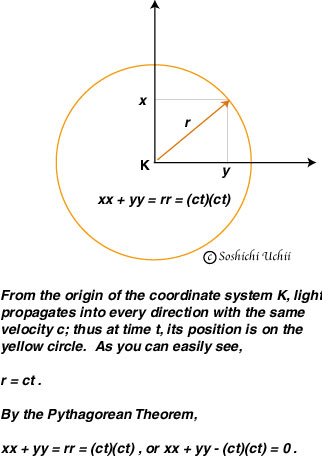|
Time Travel Research Center © 2005 Cetin BAL - GSM:+90 05366063183 - Turkey/Denizli |
Addition of Velocities
Law of Propagation of Light and Relativity Principle
Section Six, Section Seven
Einstein states the Theorem of the addition of velocities in Section Six. Let us apply this theorem to the light emitted by you on the embankment, as seen by you and by Einstein on the carriage traveling with velocity v into the same direction as the light.
When Einstein talks about the velocity of light, he has not only kinematical or mechanical laws in mind but also the electromagnetism in general (one of the major fields of physics); he intends to include all these fields into the sphere of the principle of relativity. Thus Einstein concludes as follows:
But this result comes into conflict with the principle of relativity set forth in Section 5. For, like every other general law of nature, the law of the transmission of light in vacuo must, according to the principle of relativity, be the same for the railway cariage as reference-body as when the rails are the body of reference. (pp. 22-23)
Where did we go wrong? Einstein predicts his answer:
As a result of an analysis of the physical conceptions of time and space, it became evident that in reality there is not he least incompatibility between the principle of relativity and the law of propagation of light, and that by systematically holding fast to both these laws a logically rigid theory could be arrived at. This theory has been called the special theory of relativity ... (pp. 23-24)
Derivation of the Lorentz Transformation
Appendix One
Einstein's derivation of the Lorentz transformation is not difficult, until he begins to discuss the propagation of a light signal. If you feel some difficulty, imagine the two-dimensional case where the signal propagates on the x-y surface, as in the following figure.
Since the light travels with the same velocity c into every direction, it depicts a circle of the radius r (i.e. ct), after time t. From this fact, it is easy to see that the square of the radius equals the sum of the square of x and the square of y. And if you generalize this to the three-dimensional case, you can understand Einstein's formula on page 136.
Incidentally, the relation
xx + yy = (ct)(ct) ,
together with the constancy of the velocity of light (in all inertial systems), is crucial for determining the Lorentz transformation, and hence the properties of Lorentz geometry characterized by it. In short, by treating time externally, and applying the Euclidean geometry to space, we obtained the essential relation for the Lorentz geometry, which treats time internally, on a par with spatial coordinates (time coordinate and spatial coordinates interact with each other, so to speak; and this aspect was very nicely captured by Minkowski space). In a technical word, the preceding relation is responsible for determining the Lorentzian metric, which completely determines the Lorentz geometry (you already know the Lorentzian metric; see the formula below the figure of Minkowski Space in Rods and Clocks).
Did anyone have this question: Is there any simpler (both mathematically and conceptually) derivation of the Lorentz transformation? Alan Macdonald offers "World's Fastest Derivation of the Lorentz Transformation"! He derives the Lorentz transformation, only in a page, from two assumptions:
(A) The speed of light is the same in all inertial frames, and (B) a clock moving with constant velocity v, in an inertial frame, runs at a constant rate (presumably depending on v) with respect to the synchronized clocks (at rest in the same frame) which it passes. Notice that (B) follows from Einstein's relativity principle.
Last modified, April 18, 2002. (c) Soshichi Uchii
Hiçbir yazı/ resim izinsiz olarak kullanılamaz!! Telif hakları uyarınca bu bir suçtur..! Tüm hakları Çetin BAL' a aittir. Kaynak gösterilmek şartıyla siteden alıntı yapılabilir.
The Time Machine Project © 2005 Cetin BAL - GSM:+90 05366063183 -Turkiye/Denizli
Ana Sayfa /
index /Roket bilimi /![]() E-Mail /CetinBAL/Quantum Teleportation-2
E-Mail /CetinBAL/Quantum Teleportation-2
Time Travel Technology /Ziyaretçi Defteri /UFO Technology/Duyuru


